9
Side hustles
BENEFITS OF A SIDE HUSTLE
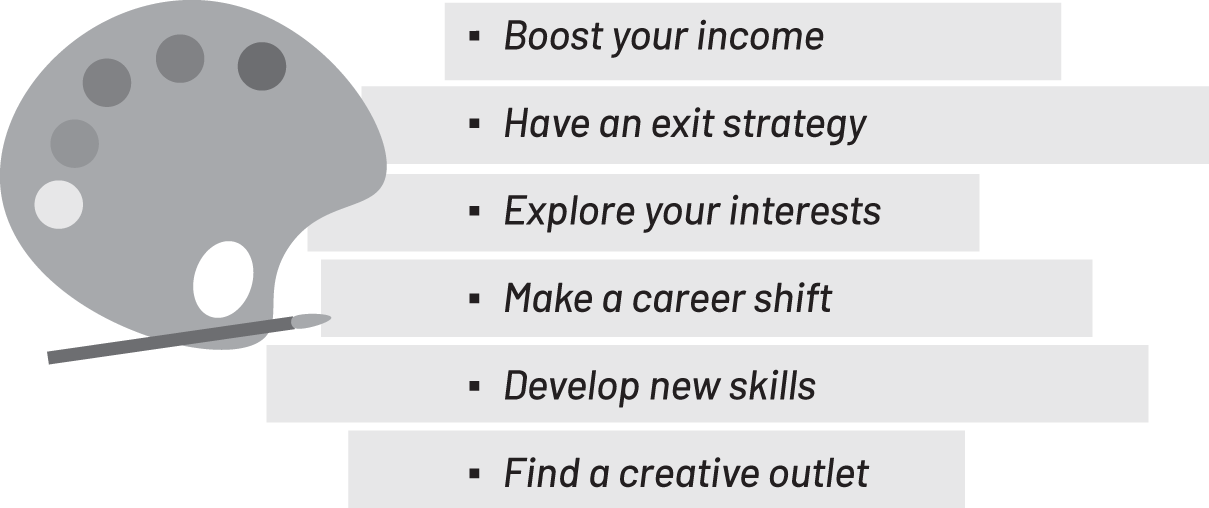
A side hustle is a form of additional income from a job you complete outside your main employment. There are a variety of benefits and reasons why you may want to start a side hustle.
BOOST YOUR INCOME
One of the most popular reasons for starting a side hustle is to increase your income. An extra $100 a week adds up to $5200 a year, and if your side hustle brings in $500 each week, that adds up to a cool $26 000 a year. No matter how much money your side hustle brings in each week, it is definitely a boost to your bank account at the end of the year. Starting a side hustle can help you boost your savings, pay off debt faster, build your emergency fund, increase your investments and hit your money goals faster.
HAVE AN EXIT STRATEGY
Another reason why you may want to start a side hustle is to create a pathway out of your current job and into self-employment. Instead of diving straight into running your own business, building it up on the side allows you to maintain your regular pay cheque and create a level of consistency and stability so you feel comfortable making the transition. How do you know when it's the right time to take your side hustle full time? It'll be different for everyone, but having an emergency fund consisting of three to six months of your living expenses will help keep your mind at ease.
EXPLORE YOUR INTERESTS
If you are not quite sure what you want to do with your career, a side hustle is a great way to explore your interests, test out different things and figure out your next step. Make a list of all your interests and think of side hustles that may align with those interests. This is a low-risk way to find out exactly what you're passionate about.
MAKE A CAREER SHIFT
Changing industries or fields is hard, especially when you don't have any experience. Starting a side hustle can help you build up this experience to add to your resumé and make the shift. Think of it as creating your own work experience job to prepare you for the next big career step.
DEVELOP NEW SKILLS
Starting a side hustle also allows you to expand your knowledge, upskill and learn new things. If you want to grow your writing skills, offer blog-writing services to businesses. If you want to get better with Excel data management, offer Excel database cleaning services to businesses. To help get started, ask your family and friends if they would be interested in you providing your services and skills.
FIND A CREATIVE OUTLET
Finding ways to monetise certain hobbies is a great way to do what you love and make money while doing so. For example, if you love fitness, you could teach group exercise classes on weekends. Or if you love painting, you could create an online store to sell your artwork.
STARTING A SIDE HUSTLE
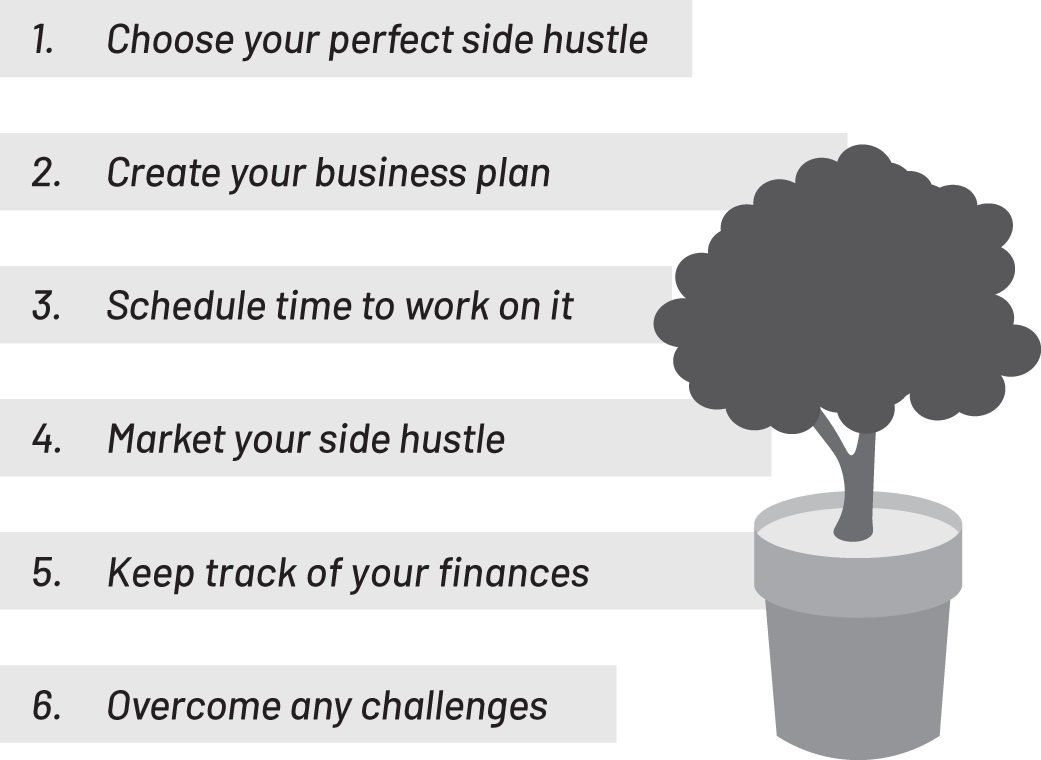
Over the next few pages, we will work through the six steps to follow to launch your side hustle. Not every step will be relevant for your side hustle, so adapt and apply any of the tips to suit you.
CHOOSING A SIDE HUSTLE
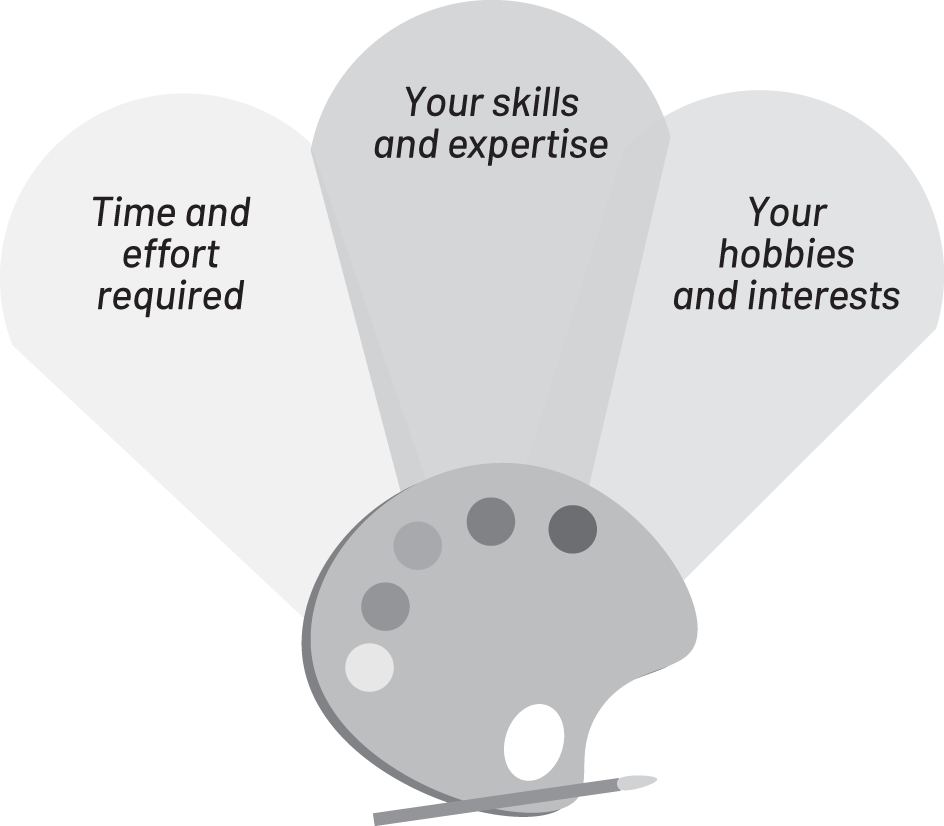
If you want to start a side hustle, the first step is choosing one that best suits your interests and lifestyle. Here are three factors to consider.
TIME AND EFFORT REQUIRED
A great place to start when determining what side hustle to pursue is deciding how much time and effort you want to commit to it. Below are some examples of low-, medium- and high-effort side hustles.
- Low-effort side hustles: online surveys, user testing
- Medium-effort side hustles: dog walking, re-selling items, food delivery
- High-effort side hustles: starting an e-commerce store, freelancing, content creator
Generally speaking, the higher the effort required, the greater the potential reward and income may be.
YOUR SKILLS AND EXPERTISE
Another thing to consider are your skills and expertise. Grab a sheet of paper and make a list of all the hard and soft skills you have. Hard skills refer to the technical knowledge you have acquired through formal education and training programs; for example, web design and copywriting are hard skills. On the other hand, soft skills are often described as ‘people' skills and are the personal qualities you possess. Some examples of soft skills include leadership, creativity and critical thinking. Based on your list of skills, brainstorm some possible side hustle ideas that incorporate your skills.
If you get stuck with writing out your skills, think about what your friends and your team at work always ask for your help with. If you find that you repeatedly get asked to help with the same things, this may be a good indication of what side hustle you should start.
YOUR HOBBIES AND INTERESTS
Lastly, consider any hobbies or interests you have. Are there any that you can monetise or translate into a side hustle? You will be spending a large portion of your free time working on your side hustle, so it is beneficial to choose something you enjoy doing.
SIDE HUSTLE IDEAS
Below are 50+ side hustle ideas to get you started.
E-commerce store
Social media management
User testing
Dog walking
Tutoring
Copywriting
Coaching
Virtual assistant
Content creation
Online surveys
Photography
Food delivery
Fitness instruction
Pet sitting
Styling
Web design
Event planning
Exam invigilation
Sell on Etsy
House organisation
Podcasting
Interior decorating
Uber driving
Advertising specialist
Resumé writing
Mystery shopping
Translation
House sitting
Videography
Affiliate sales and marketing
Course creation
Craft/sewing
Rent your car out
Dropshipping
Personal training
Video editing
Tour guide
DJ
Calligraphy
Gardening
Sell on Amazon
Bookkeeping
Teach a language
Cleaning
Blog writing
Sport referee/umpire
Exam paper marking
Painting
Pet training
Musician
Babysitting
Data entry
MAKE A BUSINESS PLAN
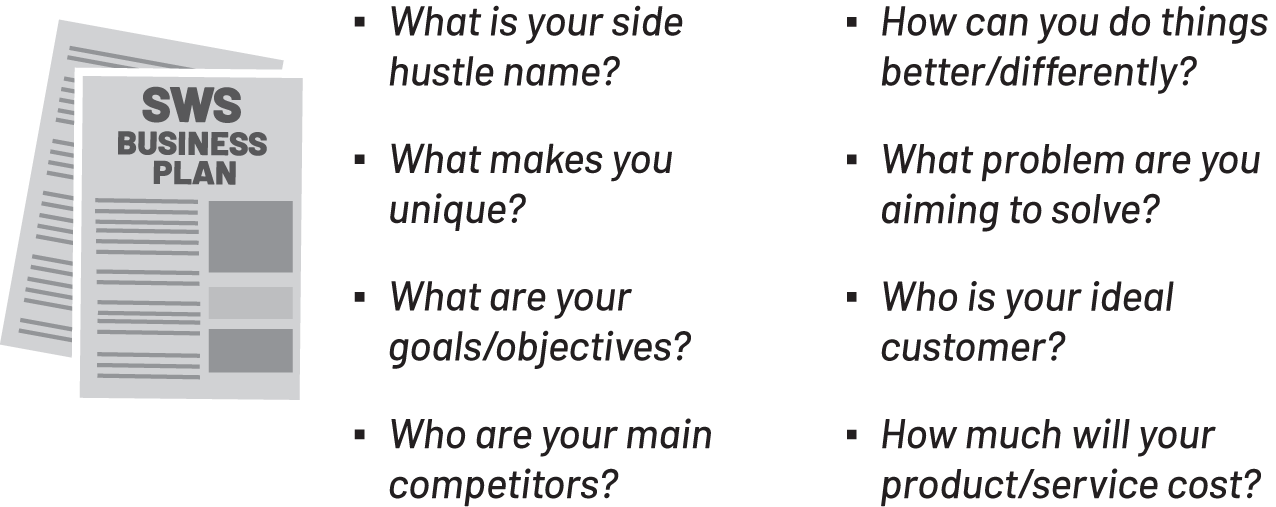
After you have chosen your perfect side hustle, spend some time working through these questions to help you define what you want to achieve with your side hustle, how your offering is unique and who you aim to serve with your product or service.
Be as detailed as possible when answering each question. For example, when defining your ideal customer, think about their age, goals, occupation, relationship status, dreams, hobbies, education, challenges and values.
Any good business or side hustle should solve a problem for their ideal customer. People should want to come to you because you have the solution to their problem/pain points. Research your ideal customer's pain points. Search for common questions in Facebook groups and other online forums that talk about your specific focus. Pay attention to what people are saying and read between the lines — the better you can help people solve their problems, the more successful your side hustle will be.
These questions will help you gain clarity on your side hustle and can be referred back to throughout your journey.
MANAGE YOUR TIME
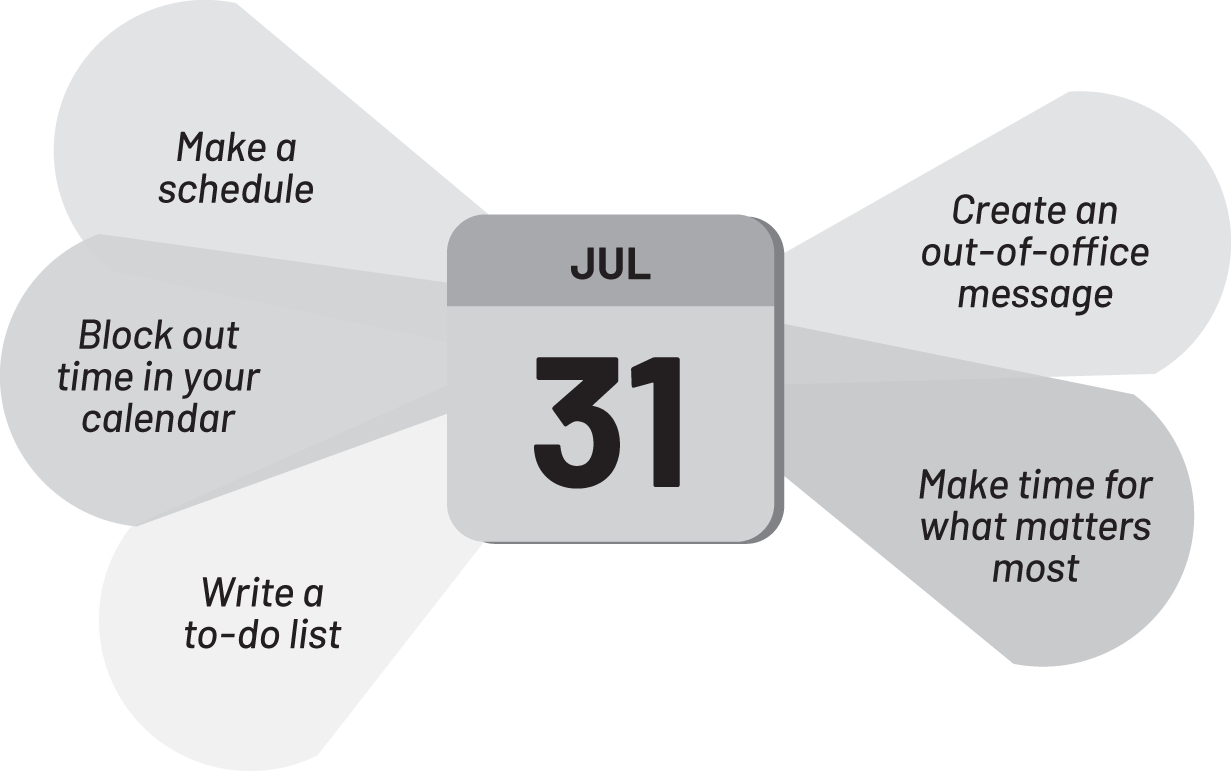
Managing your time effectively when you have a side hustle is crucial, or you risk burning yourself out.
MAKE A SCHEDULE
Determine how many hours and days you will commit to your side hustle. Will you only work on your side hustle on weekends? Will you dedicate a few hours every night after work? Pick your schedule and stick to it — and make sure you tell your side hustle clients or customers when your ‘office hours' will be to avoid out-of-hours distractions.
BLOCK OUT TIME IN YOUR CALENDAR
Schedule your working time in your calendar to keep yourself accountable. Treat this like any other meeting or appointment, and avoid booking in any other activities during these times.
WRITE A TO-DO LIST
List out all the tasks you want and need to get done. Break down big tasks into smaller chunks and focus on completing one step at a time.
CREATE AN OUT-OF-OFFICE MESSAGE
If you plan to be away for a weekend or have a special occasion, set an out-of-office message for any side hustle communications to avoid being stuck to your email in case a client/customer reaches out.
MAKE TIME FOR WHAT MATTERS MOST
Working on your side hustle is important, but don't forget to also make time for what matters most: self-care, rest, downtime and spending time with friends and family.
MARKETING YOUR SIDE HUSTLE
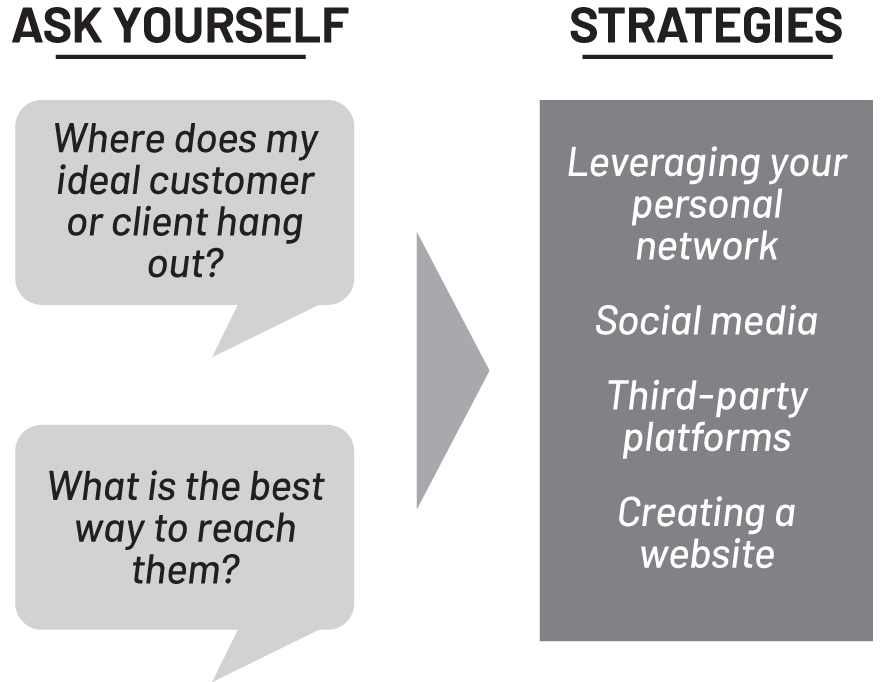
Marketing is undoubtedly one of the hardest parts of any side hustle. You may have an amazing and unique offering, but you need to get your name out there and start making some sales. The best place to start is by asking yourself where your ideal customer or client hangs out and what is the best way of reaching them. Your time and resources are limited, so you want to be strategic with your marketing tactics.
There is no hard and fast rule for what specific marketing strategies will work for you and your side hustle. Once you understand your ideal customer or client, it is all about testing a variety of strategies and being persistent.
YOUR PERSONAL NETWORK
Your personal network is the best place to start to let people know that you are in business and to find your first client/customer. The people who know you will be more willing to give you a chance when you have no experience, and it will be less intimidating to ask for a glowing testimonial and a referral. Use your personal social media accounts to announce your side hustle and spread the word. You may also choose to offer a discounted introductory rate as you get started.
SOCIAL MEDIA
In this day and age, social media is a necessity when it comes to promoting your side hustle. Not only does it help increase your exposure, but it also allows you to connect with your existing and potential customers and clients on a much deeper level than ever before. Look back on your answers to the questions from your business plan on page 155 — what social media platforms does your ideal customer or client use? A younger target audience is likely on TikTok, whereas if you are targeting mid-career professionals, you would have better luck on LinkedIn.
Start with one or two platforms and learn how to use them well before incorporating another platform. It is better to use one platform strongly than spread yourself too thin across multiple. There are three main ways to help you gain followers, increase brand recognition and make sales fast: content, engagement and collaboration.
CONTENT
Consistency and creating valuable content are the two most important parts of your social media game. Social media can often be the last thing on your mind, so get organised by planning, creating and scheduling your content ahead of time to avoid feeling overwhelmed. If you have no idea what exactly to post, follow the 80/20 rule: 80 per cent of your content should educate, inform, inspire or entertain; the other 20 per cent should be used to sell. And lastly, but also most importantly, be unique and have fun. People relate to other people, so be yourself and show off your personality.
ENGAGEMENT
The main purpose of social media is to be social. Engage with your audience and similar accounts to help you build authentic relationships. Keep talking to your customers to learn more about their needs and get to know them better. Ask them what made them decide to buy your products or services and if anything caused them trouble or concern. You can use this feedback to update and refine your side hustle.
COLLABORATION
Collaborating with others running similar or related side hustles to yours exposes you to new audiences and allows your followers to see new perspectives. Be friendly and build authentic relationships with others. You may want to collaborate to produce content, do a giveaway or share information with your audiences.
THIRD-PARTY PLATFORMS
Another way to expose your side hustle to a wider audience is to utilise third-party platforms and websites that already have an existing audience. Here are some suggestions for both product-based and service-based side hustles.
PRODUCT-BASED SIDE HUSTLES
- Amazon is a trusted platform that can give you exposure to a very large audience, however, it can be difficult to stand out and rank among the many other products.
- Similar to Amazon, eBay is a large marketplace, however, be wary of higher selling fees.
- Etsy caters to a more niche market than Amazon and eBay, and is known for its low fees and ease of use.
- Facebook Marketplace's primary focus is buying and selling local goods.
SERVICE-BASED SIDE HUSTLES
- Freelance job boards: Sites like Fiverr, Upwork and Freelancer allow you to apply for ‘jobs' posted by other users. Although this is the most straightforward way to find clients, the competition is high and payments can be low.
- Facebook groups: Join industry-related and general business groups on Facebook. Regularly scan groups and apply as soon as an interesting job shows up, or put yourself out there and post what you have to offer and that you are looking for new clients.
- Cold emailing: This one can be scary, but cold emails can also be the most effective way of getting high-paying clients. Research and find potential clients and link your website in your email. You might only receive a few replies, but those may develop into some incredible collaborations.
CREATING A WEBSITE
Even if your side hustle is done locally or you sell through a bigger third-party platform like the ones listed here, it is still a good idea to create a website for your side hustle. A website legitimises your side hustle and hosts all the information that your potential customers or clients need to know about you and your offer. Here are some of the elements that you may want to include on your website:
- About page
- What you offer
- High-quality photography
- Online store
- Portfolio/project gallery
- Current/past clients
- Testimonials
- Blog
- Terms and conditions
- Privacy policy
- Press/media page
- Contact form.
There are many websites, like WIX, Shopify or Squarespace, that make DIYing your own website simple, or you can hire a professional website developer to make one for you.
IN PERSON
Your side hustle may be best seen in person. Head down to your local community markets, take to the streets or head to the next relevant industry event and start spreading the word about what you do.
SIDE-HUSTLE FINANCES
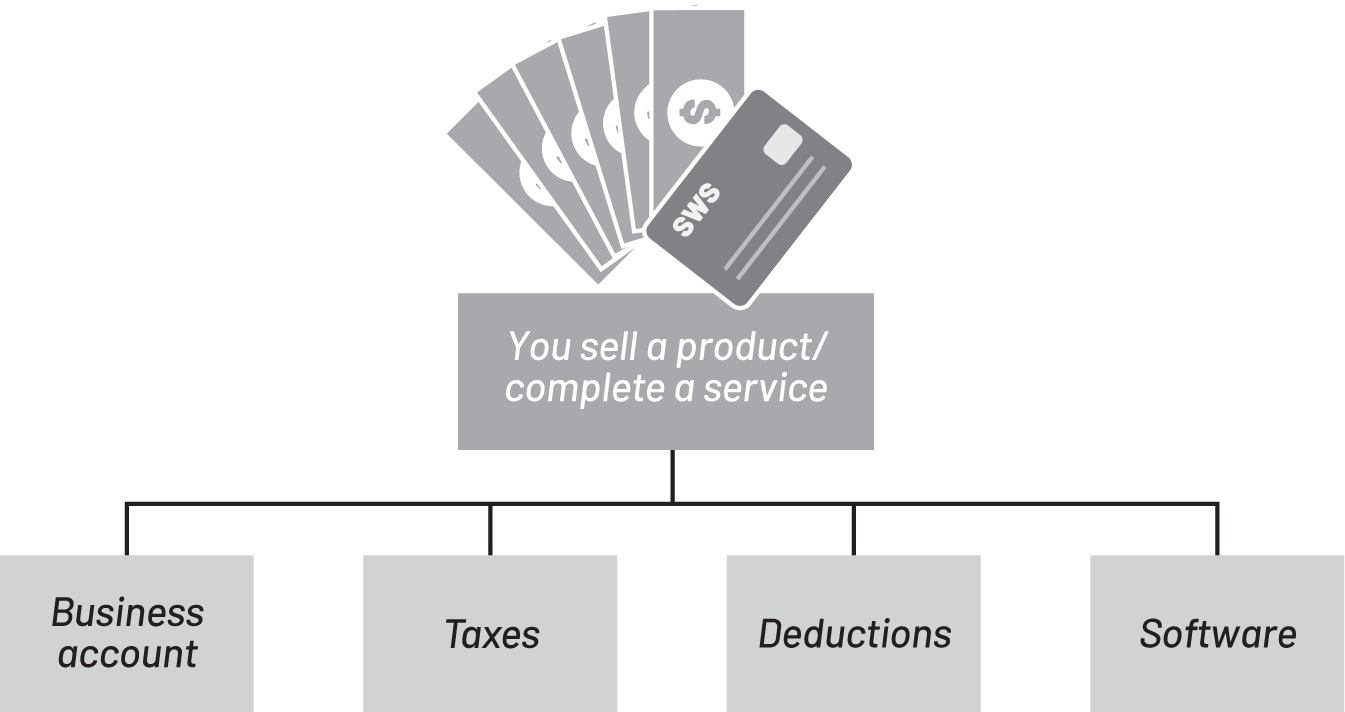
So you're making money from your side hustle — yay! But before you get too excited and spend it all, make sure your business finances are in order and you are keeping taxes in mind. For more personalised information, speak to an accountant about the financial and tax implications of your specific side hustle.
SEPARATE BUSINESS ACCOUNT
Set up a separate bank account to keep track of your side hustle income and expenses. This will allow you to never confuse your personal and side-hustle money and will simplify everything for tax season. Remember to also keep all invoices and receipts from any expenses you make during the year.
TAXES
When you receive your side-hustle income, it is likely that you will not have already paid taxes on this money. Make sure to keep a portion of this money aside for taxes (aim for at least 30 per cent) and declare all income earned from your side hustle on your tax return. You may also have to pay goods and services tax (GST) and/or sales tax depending on how much you make and where you live.
DEDUCTIONS
Make sure you know what expenses you can claim deductions for to decrease your tax payable. Generally, anything you spend that relates to you making your side-hustle income will be deductible. This means if you buy a new camera for your photography side hustle, you can claim this as a tax deduction. For more details, check out your relevant tax authority, such as the ATO.
ACCOUNTING SOFTWARE
Keep track of all your income and expenses using a bookkeeping program like Xero, MYOB or Wave. There are many options out there, so do your research and pick one that works best for you and your side hustle. While using accounting software is not compulsory, it will definitely make your life easier.
SIDE-HUSTLE CHALLENGES

Having a side hustle can be incredibly rewarding, but you will undoubtedly come across various challenges. Here are five of the most common roadblocks you may face and tips on how to overcome them.
CONFLICTS OF INTEREST
Your employer may restrict your ability to have a side hustle if it is in direct competition with the work you already do for them, or if your side hustle involves a competing company. For example, if you work for a marketing agency and you want to do marketing consulting on the side, that may be a violation of your company's policies.
The contract that you signed when you were hired may also include a ‘non-compete’ clause that states that you will not go into competition with your employer during or after employment.
Double check your company's policies and the terms in your contract to make sure that your full-time job does not have any strict rules in place regarding side hustles. If you're in doubt, you can also speak to your HR department or manager.
Even if no conflicts of interest exist, make sure you stay productive at your main job. Don't start missing deadlines or drop the quality of your work because you are distracted by your side hustle.
BURNOUT
Starting your own side hustle can be hard enough as it is, but facing the constant challenge of fitting it in between your full-time work and daily life activities can be exhausting. The issue of burning out when you are trying to start a side hustle is high, so it is important that you consciously manage this balance.
There are a few ways you can prevent burnout. Firstly, manage your time strictly and fit your side hustle in during your most productive working hours. Secondly, set aside time to practise regular self-care. Your health is always your top priority, so recognise when you are feeling burnt out and take a step back to rest and recharge.
START-UP COSTS
Your side hustle idea may require some initial start-up costs like buying inventory or equipment. Don't let start-up costs discourage you from starting your side hustle. Investing some money up front may be necessary so you can reap the massive rewards later. Set aside a portion of your income to go towards a ‘start-up fund' and avoid going into debt unless you are confident you can repay it quickly. Reinvest your initial profits back into your side hustle to buy more equipment/materials or to undertake further upskilling so that you can keep growing into the future.
DIFFICULT CUSTOMERS OR CLIENTS
While you will have positive interactions with most of your customers or clients, it is likely that you will also encounter some difficult ones. People demanding a refund, not paying you for your services, changing the scope of work, ignoring your requests for payment … and the list goes on. It can definitely be deflating and exhausting when you encounter these sorts of customers or clients, but there are a few ways you can manage them.
MAKE A CONTRACT
Before starting with a new client, set a clear scope of work that is agreed to by both parties. This scope of work should clearly define all deadlines and how you will deal with any extra inclusions or modifications. There are websites that have contract templates you can use as a starting point. Alternatively, you can consult with a legal professional if you want to make sure that this document adequately protects you.
HAVE CLEAR PAYMENT TERMS
Be clear on when you expect payment and define late payment fees. Avoid invoicing for the total price at the end, as clients can just avoid paying your invoice when they've already received your work.
If you do end up in a situation where your client has not paid, send friendly reminder emails the day and week after payment is due and reattach the invoice. If this fails, try and discuss with your client why they have not yet paid and reiterate your payment terms. Remain calm during this process and remind yourself that you have a legal right to payment for your work. If all else fails, consider taking legal action or engaging a debt collector to recover your payment.
REFUND POLICIES
Make sure that you have a robust refund policy in place that clearly states in what circumstances you will give a customer a refund. Check the laws in your area to make sure that your policy is in line with the relevant consumer law.
LOSS OF MOTIVATION
As you pursue your side hustle, you may go through periods where you are struggling to stay motivated and committed to it. If this is the case, remember why you started your side hustle in the first place. Was it to pay off your debts faster, to quit the job you hate or to save up for a holiday? Whatever it is, use that as motivation to stay on track.
